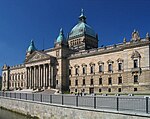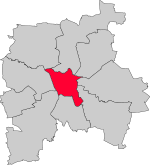Saxon Academy of Sciences and Humanities
1846 establishments in Germany1846 establishments in SaxonyScientific organizations established in 1846Union of German Academies of Sciences and Humanities

The Saxon Academy of Sciences and Humanities in Leipzig (German: Sächsische Akademie der Wissenschaften zu Leipzig) is an institute which was founded in 1846 under the name Royal Saxon Society for the Sciences (German: Königlich Sächsische Gesellschaft der Wissenschaften).
Excerpt from the Wikipedia article Saxon Academy of Sciences and Humanities (License: CC BY-SA 3.0, Authors, Images).Saxon Academy of Sciences and Humanities
Karl-Tauchnitz-Straße, Leipzig center south (Mitte)
Geographical coordinates (GPS) Address Nearby Places Show on map
Geographical coordinates (GPS)
| Latitude | Longitude |
|---|---|
| N 51.3347 ° | E 12.3694 ° |
Address
Karl-Tauchnitz-Straße 1
04107 Leipzig, center south (Mitte)
Saxony, Germany
Open on Google Maps











